Development of a Rhizobium Seed Coating to Establish Lupine Species on Degraded Rangelands
Abstract
1. Introduction
2. Results
2.1. EXCEED® Trial: Evaluation of a Commercial Rhizobia Product
2.2. Inoculation Trial: Evaluation of Indigenous Rhizobia Strains on Root Nodulation and Plant Growth When Applied as a Liquid Culture to Pre-Germinated Seeds
2.3. Coating Trial: Evaluation of Indigenous Rhizobia Strains Applied with Different Seed Coatings
3. Discussion
4. Materials and Methods
4.1. Collection, Isolation, and Preparation of Indigenous Rhizobia Strains
4.2. EXCEED® Trial: Evaluation of a Commercial Rhizobium Product
4.3. Inoculation Trial: Evaluation of Indigenous Rhizobia Strains on Root Nodulation and Plant Growth When Applied as a Liquid Culture on Pre-Germinated Seeds
4.4. Coating Trial: Evaluation of Indigenous Rhizobia Strains When Applied with Different Seed Coatings
Author Contributions
Funding
Data Availability Statement
Acknowledgments
Conflicts of Interest
References
- Dimijian, G.G. Evolving Together: The Biology of Symbiosis, Part 1. Bayl. Univ. Med. Cent. Proc. 2000, 13, 217–226. [Google Scholar] [CrossRef]
- Baskett, M.L.; Gaines, S.D.; Nisbet, R.M. Symbiont Diversity May Help Coral Reefs Survive Moderate Climate Change. Ecol. Appl. 2009, 19, 3–17. [Google Scholar] [CrossRef] [PubMed]
- Oskuei, B.K.; Bandehagh, A.; Farajzadeh, D.; Lajayer, B.A.; Shu, W.; Astatkie, T. Effects of Pseudomonas Fluorescens FY32 On Canola (Brassica napus L.) Cultivars Under Drought Stress Induced by Polyethylene Glycol. Gesunde Pflanz. 2024, 76, 251–260. [Google Scholar] [CrossRef]
- Verma, S.K.; Sahu, P.K.; Kumar, K.; Pal, G.; Gond, S.K.; Kharwar, R.N.; White, J.F. Endophyte Roles in Nutrient Acquisition, Root System Architecture Development and Oxidative Stress Tolerance. J. Appl. Microbiol. 2021, 131, 2161–2177. [Google Scholar] [CrossRef] [PubMed]
- Berendsen, R.L.; Pieterse, C.M.J.; Bakker, P.A.H.M. The Rhizosphere Microbiome and Plant Health. Trends Plant Sci. 2012, 17, 478–486. [Google Scholar] [CrossRef]
- Saghafi, D.; Delangiz, N.; Lajayer, B.A.; Ghorbanpour, M. An Overview on Improvement of Crop Productivity in Saline Soils by Halotolerant and Halophilic PGPRs. 3 Biotech 2019, 9, 261. [Google Scholar] [CrossRef] [PubMed]
- Chibucos, M.C.; Tyler, B.M. Common Themes in Nutrient Acquisition by Plant Symbiotic Microbes, Described by the Gene Ontology. BMC Microbiol. 2009, 9, S6. [Google Scholar] [CrossRef]
- Ryan, R.P.; Germaine, K.; Franks, A.; Ryan, D.J.; Dowling, D.N. Bacterial Endophytes: Recent Developments and Applications. FEMS Microbiol. Lett. 2008, 278, 1–9. [Google Scholar] [CrossRef] [PubMed]
- Bent, E.; Chanway, C.P. The Growth-Promoting Effects of a Bacterial Endophyte on Lodgepole Pine Are Partially Inhibited by the Presence of Other Rhizobacteria. Can. J. Microbiol. 1998, 44, 980–988. [Google Scholar] [CrossRef]
- Chanway, C.P. Inoculation of Tree Roots with Plant Growth Promoting Soil Bacteria: An Emerging Technology for Reforestation. For. Sci. 1997, 43, 99–112. [Google Scholar] [CrossRef]
- Jacoby, R.; Peukert, M.; Succurro, A.; Koprivova, A.; Kopriva, S. The Role of Soil Microorganisms in Plant Mineral Nutrition—Current Knowledge and Future Directions. Front. Plant Sci. 2017, 8, 1617. [Google Scholar] [CrossRef]
- Murray, B.R.; Thrall, P.H.; Woods, M.J. Acacia Species and Rhizobial Interactions: Implications for Restoration of Native Vegetation. Ecol. Manag. Restor. 2001, 2, 213–219. [Google Scholar] [CrossRef]
- Thrall, P.H.; Millsom, D.A.; Jeavons, A.C.; Waayers, M.; Harvey, G.R.; Bagnall, D.J.; Brockwell, J. Seed Inoculation with Effective Root-Nodule Bacteria Enhances Revegetation Success. J. Appl. Ecol. 2005, 42, 740–751. [Google Scholar] [CrossRef]
- Cao, X. Regulating Mine Land Reclamation in Developing Countries: The Case of China. Land Use Policy 2007, 24, 472–483. [Google Scholar] [CrossRef]
- Killebrew, K.; Wolff, H. Environmental Impacts of Agricultural Technologies; Daniel, J., Ed.; Evans School of Public Policy and Governance: Seattle, WA, USA, 2010. [Google Scholar]
- Haddaway, N.R.; Cooke, S.J.; Lesser, P.; Macura, B.; Nilsson, A.E.; Taylor, J.J.; Raito, K. Evidence of the Impacts of Metal Mining and the Effectiveness of Mining Mitigation Measures on Social-Ecological Systems in Arctic and Boreal Regions: A Systematic Map Protocol. Environ. Evid. 2019, 8, 9. [Google Scholar] [CrossRef]
- Fofana, B.; Sacande, M.; Blagna, F.; Dibloni, T.O.; Compaore, E.; Sanon, K.B.; Maiga, Y.; Ouattara, A.S. Boosting Land Restoration Success in the Great Green Wall through the Use of Symbiotic Microorganisms for Propagated Tree Seedlings. Int. J. Biol. Chem. Sci. 2020, 14, 110–125. [Google Scholar] [CrossRef]
- van der Heijden, M.G.A.; de Bruin, S.; Luckerhoff, L.; van Logtestijn, R.S.P.; Schlaeppi, K. A Widespread Plant-Fungal-Bacterial Symbiosis Promotes Plant Biodiversity, Plant Nutrition and Seedling Recruitment. ISME J. 2016, 10, 389–399. [Google Scholar] [CrossRef] [PubMed]
- Chapin, F.S., III; Vitousek, P.M.; Van Cleve, K. The Nature of Nutrient Limitation in Plant Communities. Am. Nat. 1986, 127, 48–58. [Google Scholar] [CrossRef]
- Ritchie, M.E.; Tilman, D. Responses of Legumes to Herbivores and Nutrients During Succession on a Nitrogen-Poor Soil. Ecology 1995, 76, 2648–2655. [Google Scholar] [CrossRef]
- Chaer, G.M.; Resende, A.S.; Campello, E.F.C.; De Faria, S.M.; Boddey, R.M. Nitrogen-Fixing Legume Tree Species for the Reclamation of Severely Degraded Lands in Brazil. Tree Physiol. 2011, 31, 139–149. [Google Scholar] [CrossRef]
- Maluk, M.; Ferrando-Molina, F.; Lopez del Egido, L.; Langarica-Fuentes, A.; Yohannes, G.G.; Young, M.W.; Martin, P.; Gantlett, R.; Kenicer, G.; Hawes, C.; et al. Fields with No Recent Legume Cultivation Have Sufficient Nitrogen-Fixing Rhizobia for Crops of Faba Bean (Vicia faba L.). Plant Soil 2022, 472, 345–368. [Google Scholar] [CrossRef]
- Bennett, G.M.; Lloyd, J. Seed Inoculation, Coating, and Precision Pelleting Science, Technology and Practical Applications; CRC Press Taylor and Francis Group: New York, NY, USA, 2016. [Google Scholar]
- Biswas, J.C.; Ladha, J.K.; Dazzo, F.B. Rhizobia Inoculation Improves Nutrient Uptake and Growth of Lowland Rice. Soil Sci. Soc. Am. J. 2000, 64, 1644–1650. [Google Scholar] [CrossRef]
- Udvardi, M.; Poole, P.S. Transport and Metabolism in Legume-Rhizobia Symbioses. Annu. Rev. Plant Biol. 2013, 64, 781–805. [Google Scholar] [CrossRef]
- Ma, H.; Egamberdieva, D.; Wirth, S.; Bellingrath-Kimura, S.D. Effect of Biochar and Irrigation on Soybean-Rhizobium Symbiotic Performance and Soil Enzymatic Activity in Field Rhizosphere. Agronomy 2019, 9, 626. [Google Scholar] [CrossRef]
- Kavusi, E.; Ansar, B.S.K.; Dehghanian, Z.; Lajayer, B.A.; Nobaharan, K.; Ma, Y.; Glick, B.R. Delivery of Beneficial Microbes via Seed Coating for Medicinal and Aromatic Plant Production: A Critical Review. J. Plant Growth Regul. 2022, 42, 575–597. [Google Scholar] [CrossRef]
- Pawar, V.A.; Pawar, P.R.; Bhosale, A.M.; Chavan, S. V Effect of Rhizobium on Seed Germination and Growth of Plants. J. Acad. Ind. Res. (JAIR) 2014, 3, 84–88. [Google Scholar]
- Horikawa, Y.; Ohtsuka’, H. Effects of Coating and Adhesive on the Inoculation Rhizobium Metiloti to Alfalfa (Medicago sativa L.) Seeds for Nodulation and Seedling Growth. Jpn. J. Grassl. Sci. 1996, 41, 275–279. [Google Scholar]
- Yang, S.; Tang, F.; Muqiang, G.; Krishnan, H.B.; Zhu, H. R Gene-Controlled Host Specificity in the Legume-Rhizobia Symbiosis. Proc. Natl. Acad. Sci. USA 2010, 107, 18735–18740. [Google Scholar] [CrossRef] [PubMed]
- Wang, Q.; Liu, J.; Zhu, H. Genetic and Molecular Mechanisms Underlying Symbiotic Specificity in Legume-Rhizobium Interactions. Front. Plant Sci. 2018, 9, 313. [Google Scholar] [CrossRef]
- Irisarri, P.; Cardozo, G.; Tartaglia, C.; Reyno, R.; Gutiérrez, P.; Lattanzi, F.A.; Rebuffo, M.; Monza, J. Selection of Competitive and Efficient Rhizobia Strains for White Clover. Front. Microbiol. 2019, 10, 768. [Google Scholar] [CrossRef]
- Karaca, Ü.; Uyanöz, R. Effectiveness of Native Rhizobium on Nodulation and Growth Properties of Dry Bean (Phaseolus vulgaris L.). Afr. J. Biotechnol. 2012, 11, 8986–8991. [Google Scholar] [CrossRef]
- Singleton, P.W.; Tavares, J.W. Inoculation Response of Legumes in Relation to the Number and Effectiveness of Indigenous Rhizobium Populations. Appl. Environ. Microbiol. 1986, 51, 1013–1018. [Google Scholar] [CrossRef] [PubMed]
- Hoose, B.W.; Call, R.S.; Bates, T.H.; Anderson, R.M.; Roundy, B.A.; Madsen, M.D. Seed Conglomeration: A Disruptive Innovation to Address Restoration Challenges Associated with Small-Seeded Species. Restor. Ecol. 2019, 27, 959–965. [Google Scholar] [CrossRef]
- van Schreven, D.A.; Lindenbergh, D.J.; Koridon, A. Effect of Several Herbicides on Bacterial Populations and Activity and the Persistence of These Herbicides in Soil. Plant Soil 1970, 33, 513–532. [Google Scholar] [CrossRef]
- Thompson, J.A. Production and Quality Control of Legume Inoculants. In Methods for Evaluating Biological Nitrogen Fixation; Bergersen, F.J., Ed.; John Wiley & Sons: Chichester, UK, 1980; pp. 489–533. [Google Scholar]
- Casteriano, A.; Wilkes, M.A.; Deaker, R. Physiological Changes in Rhizobia after Growth in Peat Extract May Be Related to Improved Desiccation Tolerance. Appl. Environ. Microbiol. 2013, 79, 3998–4007. [Google Scholar] [CrossRef] [PubMed]
- Głodowska, M.; Husk, B.; Schwinghamer, T.; Smith, D. Biochar Is a Growth-Promoting Alternative to Peat Moss for the Inoculation of Corn with a Pseudomonad. Agron. Sustain. Dev. 2016, 36, 21. [Google Scholar] [CrossRef]
- Ben-Laouane, R.; Ait-El-Mokhtar, M.; Anli, M.; Boutasknit, A.; Ait Rahou, Y.; Raklami, A.; Oufdou, K.; Wahbi, S.; Meddich, A. Green Compost Combined with Mycorrhizae and Rhizobia: A Strategy for Improving Alfalfa Growth and Yield Under Field Conditions. Gesunde Pflanz. 2020, 73, 193–207. [Google Scholar] [CrossRef]
- Otieno, P.E.; Muthomi, J.W.; Chemining’wa, G.N.; John, H.N. Effect of Rhizobia Inoculation, Farm Yard Manure and Nitrogen Fertilizer on Nodulation and Yield of Food Grain Legumes. J. Biol. Sci. 2009, 9, 326–332. [Google Scholar] [CrossRef]
- Ingham, R.E.; Trofymow, J.A.; Ingham, E.R.; Coleman, D.C. Interactions of Bacteria, Fungi, and Their Nematode Grazers: Effects on Nutrient Cycling and Plant Growth. Ecol. Monogr. 1985, 55, 119–140. [Google Scholar] [CrossRef]
- Gamliel, A.; Austerweil, M.; Kritzman, G. Non-Chemical Approach to Soilborne Pest Management–Organic Amendments. Crop Prot. 2000, 19, 847–853. [Google Scholar] [CrossRef]
- Cogger, C.G. Potential Compost Benefits for Restoration of Soils Disturbed by Urban Development. Compost Sci Util. 2005, 13, 243–251. [Google Scholar] [CrossRef]
- Tilley, D.; Tilley, N.; Fund, A.J.; Wolf, M. Seedling Growth and Competition of a Late-Seral, Native Perennial Grass and Two Early-Seral, Native Forbs in the Presence of Two Densities of the Invasive Annual Grass Bromus tectorum L.; U.S. Department of Agriculture: Washington, DC, USA, 2019.
- Jones, C.D.; Stevens, M.R.; Jolley, V.D.; Hopkins, B.G.; Jensen, S.L.; Turner, D.; Stettler, J.M. Evaluation of Thermal, Chemical, and Mechanical Seed Scarification Methods for 4 Great Basin Lupine Species. Nativ. Plants J. 2016, 17, 5–17. [Google Scholar] [CrossRef]
- Hartley, E.J.; Gemell, L.G.; Deaker, R. Some Factors That Contribute to Poor Survival of Rhizobia on Preinoculated Legume Seed. Crop Pasture Sci. 2012, 63, 858–865. [Google Scholar] [CrossRef]
- Hardarson, G.; Golbs, M.; Danso, S.K.A. Nitrogen Fixation in Soybean (Glycine max L. Merrill) as Affected by Nodulation Patterns. Soil Biol. Biochem. 1989, 21, 783–787. [Google Scholar] [CrossRef]
- Abbasi, P.A.; Al-Dahmani, J.; Sahin, F.; Hoitink, H.A.J.; Miller, S.A. Effect of Compost Amendments on Disease Severity and Yield of Tomato in Conventional and Organic Production Systems. Plant Dis. 2002, 86, 156–161. [Google Scholar] [CrossRef] [PubMed]
- Borden, R. Geochemical Evolution of Sulphide-Bearing Waste Rock Soils at the Bingham Canyon Mine, Utah. Geochem. Explor. Environ. Anal. 2001, 1, 15–21. [Google Scholar] [CrossRef]
- Borden, R.K. Environmental Geochemistry of the Bingham Canyon Porphyry Copper Deposit, Utah. Environ. Geol. 2003, 43, 752–758. [Google Scholar] [CrossRef]
- Soil Survey Staff Web Soil Survey. Available online: https://websoilsurvey.sc.egov.usda.gov/App/WebSoilSurvey.aspx (accessed on 30 January 2020).
- Kim, M.; Chun, J. Chapter 4—16S RRNA Gene-Based Identification of Bacteria and Archaea Using the EzTaxon Server. Methods Microbiol. 2014, 41, 61–74. [Google Scholar] [CrossRef]
- Sileshi, G.W. A Critique of Current Trends in the Statistical Analysis of Seed Germination and Viability Data. Seed Sci. Res. 2012, 22, 145–159. [Google Scholar] [CrossRef]
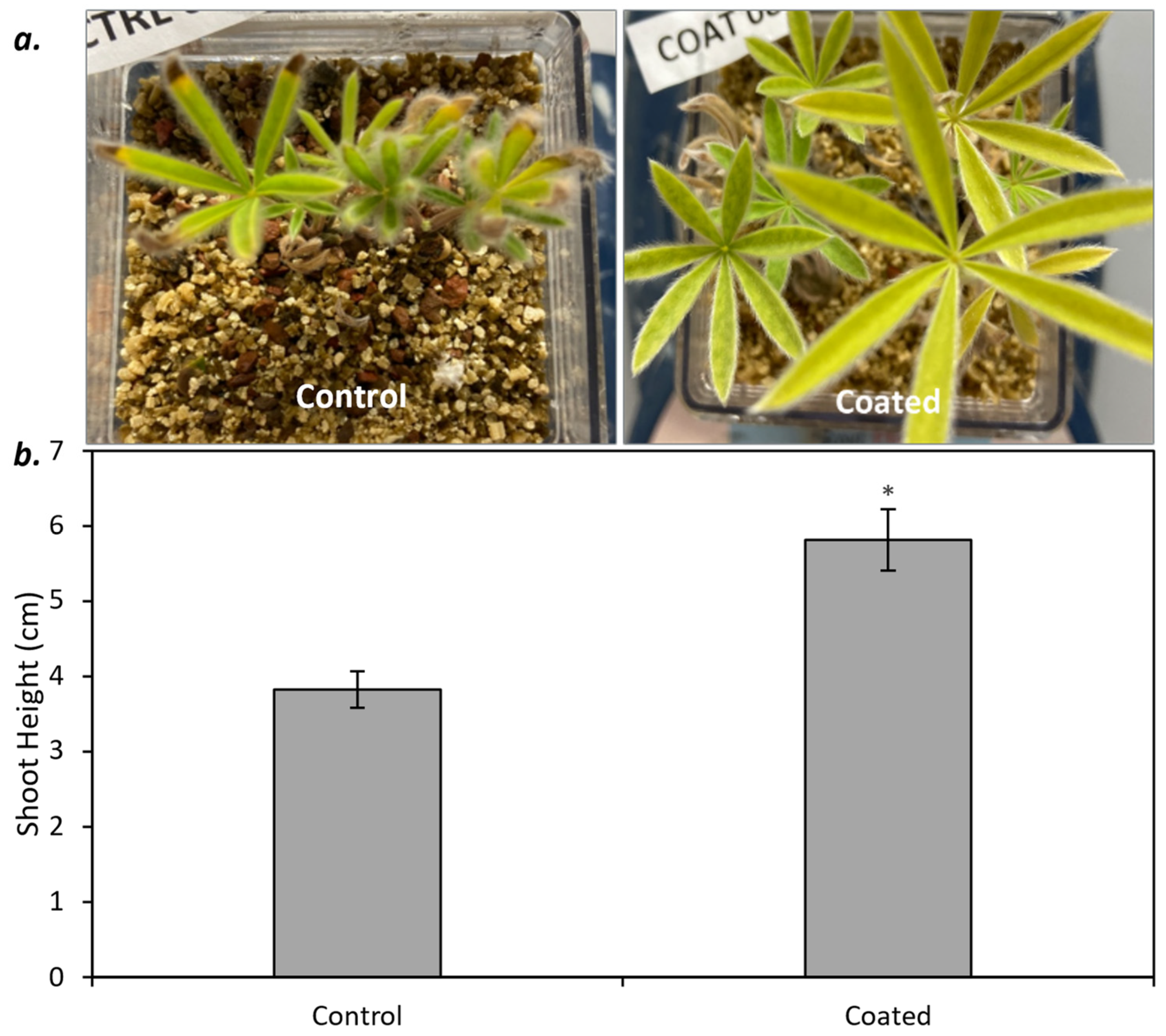
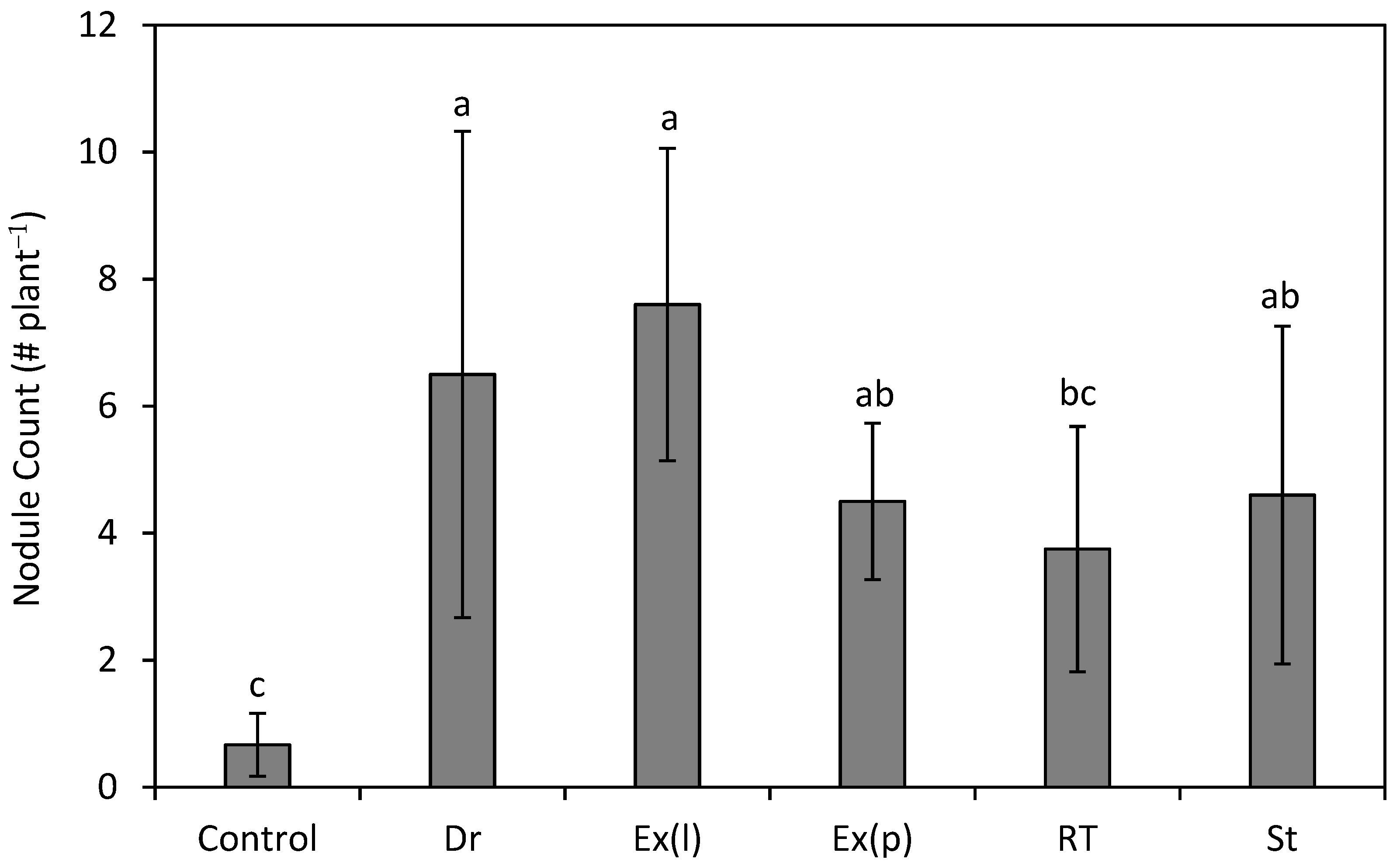

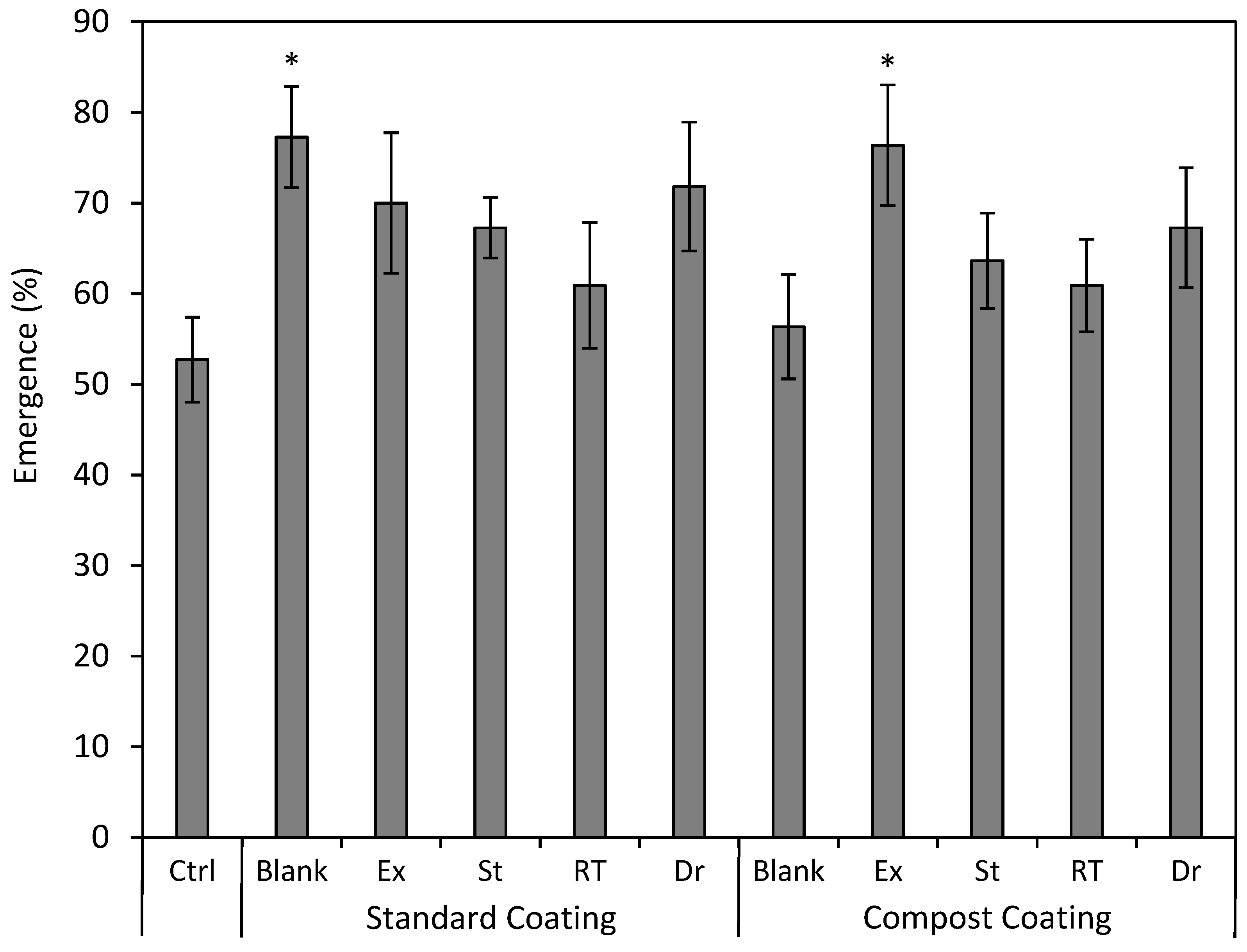
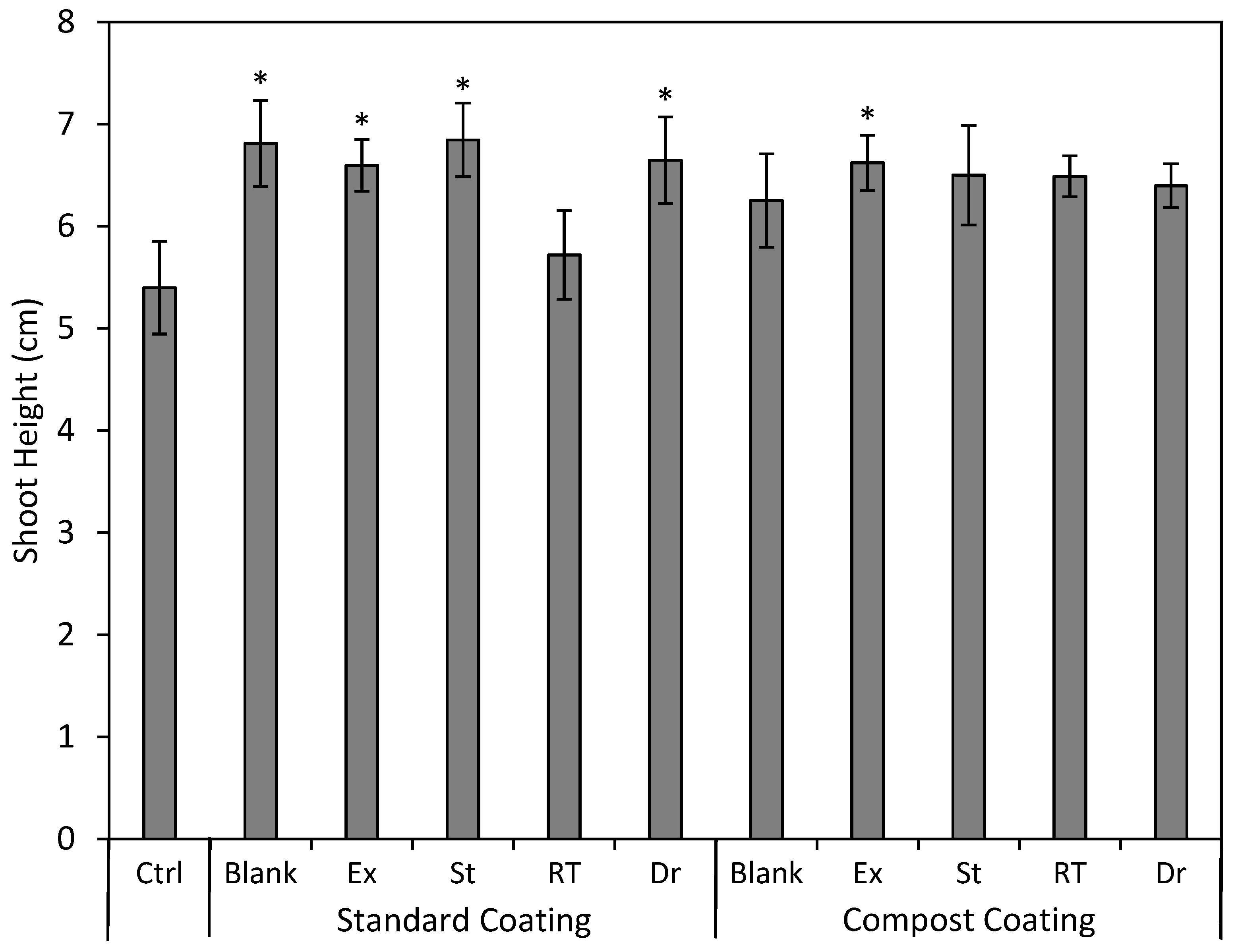
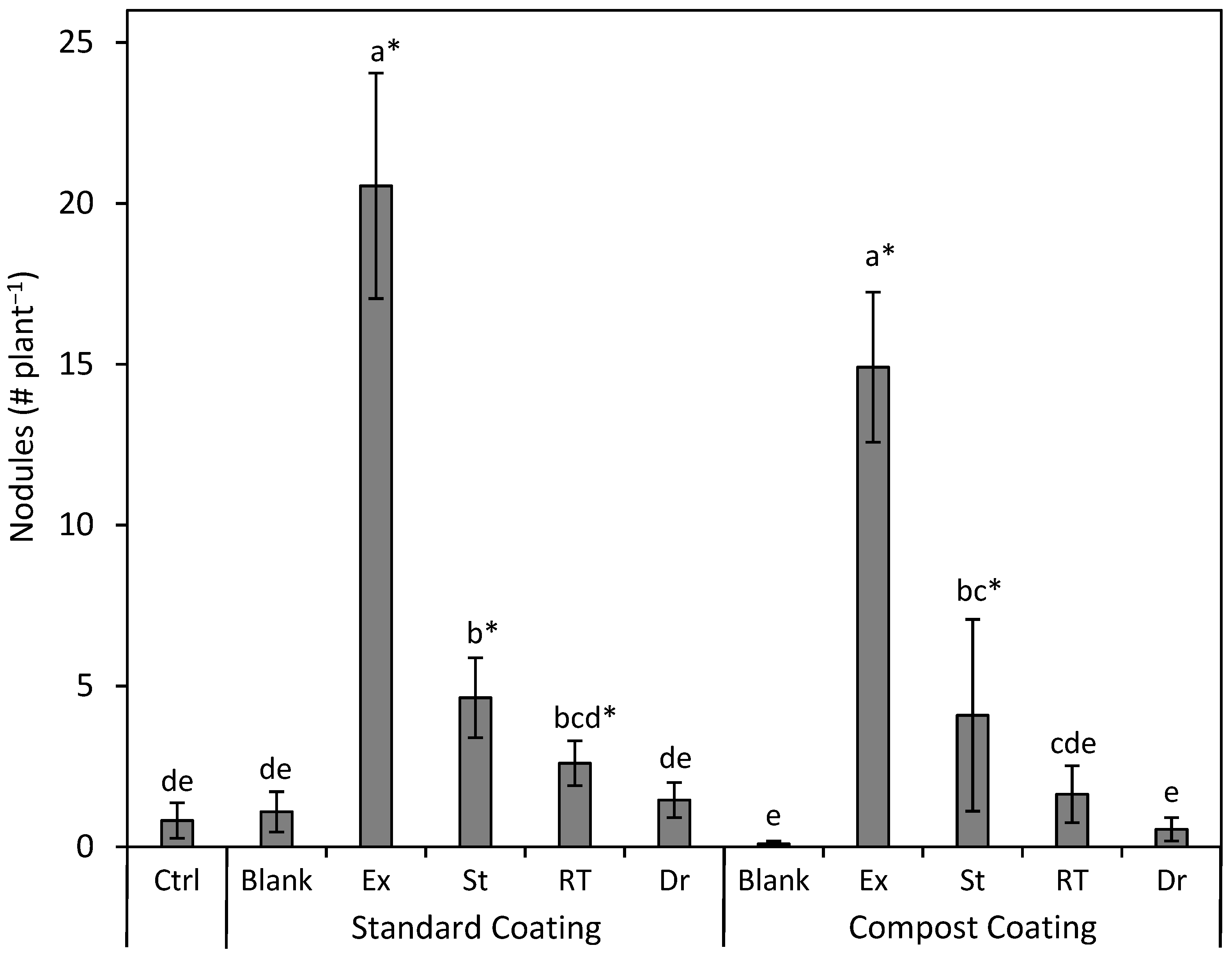
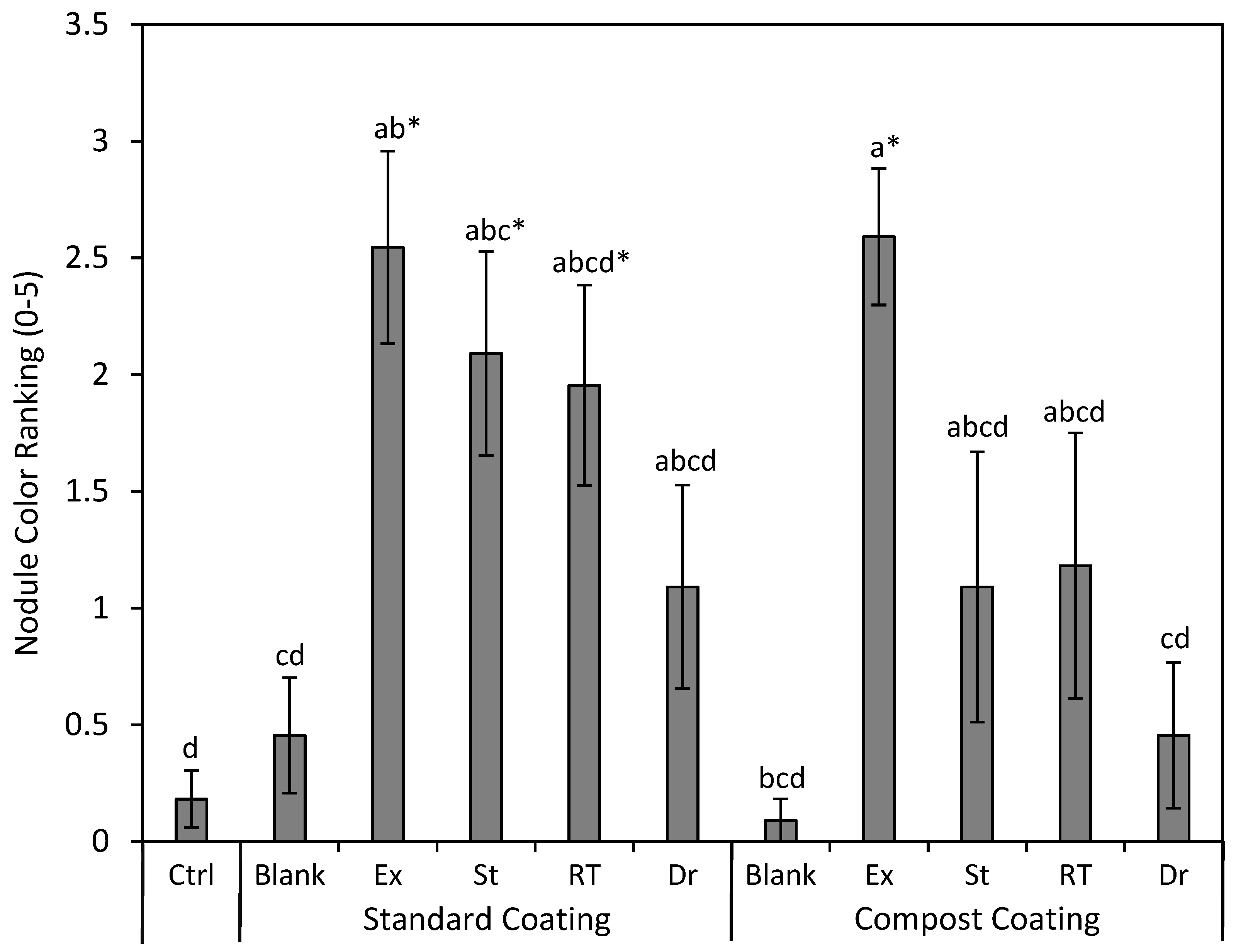
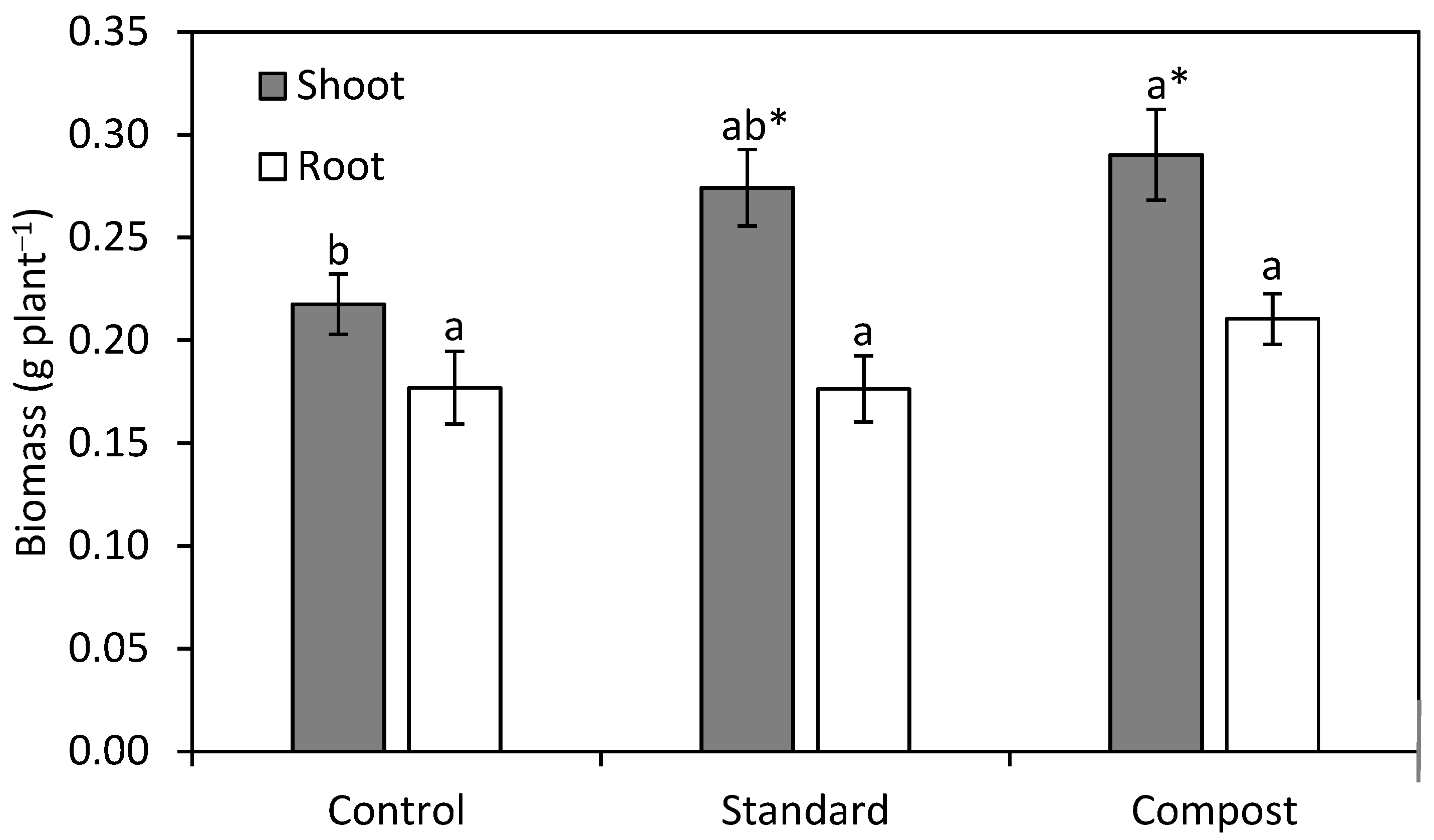
| Ingredient | Amount |
|---|---|
| Autoclaved, ddH2O | 1 L |
| Tryptone | 5 g |
| Yeast extract | 2.5 g |
| CaCl2·2H2O | 0.4 g |
| MgSO4·7H2O | 0.4 g |
| KOH | 300 µL |
| INGREDIENT | AMOUNT | |
|---|---|---|
| AUTOCLAVED, DDH2O | 500 mL | |
| 1M KH2PO4 [pH~7.0] | 1 mL | |
| 1M CACL2·2H2O | 0.25 mL | |
| 1M MGSO4·7H2O | 0.50 mL | |
| 3M KCL | 0.50 mL | |
| MICRO (SEE BELOW) | 0.50 mL | |
| MICRO | EDTA | 230 mg |
| FeCl3 | 100 mg | |
| ZnSO4 | 50 mg | |
| H3BO3 | 5 mg | |
| CuSO4 | 5 mg | |
| Na2MoO4 | 5 mg | |
| CoCl2 | 5 mg | |
| MnSO4 | 50 mg | |
| Coating | Ingredient | Amount (g) |
|---|---|---|
| SC | Wood flour (system 3) | 72 |
| Powdered cellulose (J Rettenmaier) | 13.5 | |
| Calcium Bentonite | 4.5 | |
| Peat moss (Black Gold), blended | 27.5 | |
| CC | Compost (TeaLab), sieved to #12 Tyler mesh sieve | 129.6 |
| Peat moss (Black Gold) | 24.75 |
| Treatment | Description |
|---|---|
| Control | Uncoated seed |
| SC | Seed coated with no added inoculum |
| CC | Seed coated with compost and no added inoculum |
| SC + Ex | SC with EXCEED® |
| SC + RT | SC with the native strain collected from Rio Tinto Kennecott Mine |
| SC + Dr | SC with the native strain collected near Draper, UT |
| SC + St | SC with the native strain collected near Strawberry Reservoir, UT |
| CC + Ex | CC with EXCEED® |
| CC + RT | CC with the native strain collected from Rio Tinto Kennecott Mine |
| CC + Dr | CC with the native strain collected from Draper, UT |
| CC + St | CC with the native strain collected near Strawberry Reservoir, UT |
Disclaimer/Publisher’s Note: The statements, opinions and data contained in all publications are solely those of the individual author(s) and contributor(s) and not of MDPI and/or the editor(s). MDPI and/or the editor(s) disclaim responsibility for any injury to people or property resulting from any ideas, methods, instructions or products referred to in the content. |
© 2024 by the authors. Licensee MDPI, Basel, Switzerland. This article is an open access article distributed under the terms and conditions of the Creative Commons Attribution (CC BY) license (https://creativecommons.org/licenses/by/4.0/).
Share and Cite
Church, B.M.; Geary, B.; Griffitts, J.; Drake, C.L.; Ruebelmann, K.; Nelson, S.V.; Madsen, M.D. Development of a Rhizobium Seed Coating to Establish Lupine Species on Degraded Rangelands. Plants 2024, 13, 2101. https://doi.org/10.3390/plants13152101
Church BM, Geary B, Griffitts J, Drake CL, Ruebelmann K, Nelson SV, Madsen MD. Development of a Rhizobium Seed Coating to Establish Lupine Species on Degraded Rangelands. Plants. 2024; 13(15):2101. https://doi.org/10.3390/plants13152101
Chicago/Turabian StyleChurch, Bridget M., Brad Geary, Joel Griffitts, Curtis L. Drake, Kate Ruebelmann, Shannon V. Nelson, and Matthew D. Madsen. 2024. "Development of a Rhizobium Seed Coating to Establish Lupine Species on Degraded Rangelands" Plants 13, no. 15: 2101. https://doi.org/10.3390/plants13152101
APA StyleChurch, B. M., Geary, B., Griffitts, J., Drake, C. L., Ruebelmann, K., Nelson, S. V., & Madsen, M. D. (2024). Development of a Rhizobium Seed Coating to Establish Lupine Species on Degraded Rangelands. Plants, 13(15), 2101. https://doi.org/10.3390/plants13152101






